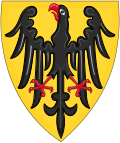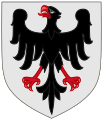User:JMvanDijk/Sandbox 9/Box 27
Duchy of Swabia | |||||||||||||||||||
|---|---|---|---|---|---|---|---|---|---|---|---|---|---|---|---|---|---|---|---|
| 915–1313 | |||||||||||||||||||
Hohenstaufen (13th century)
| |||||||||||||||||||
 The Duchy of Swabia within the German Kingdom around the start of the 11th century | |||||||||||||||||||
 Map showing the territories of Upper Burgundy (green) and the Duchy of Swabia (orange) | |||||||||||||||||||
| Status |
| ||||||||||||||||||
| Capital | None | ||||||||||||||||||
| Common languages | Latin Swabian | ||||||||||||||||||
| Religion | Roman Catholicism | ||||||||||||||||||
| Government | Feudalism Duchy | ||||||||||||||||||
| Historical era | Early Middle Ages | ||||||||||||||||||
• Proclaimed | 915 | ||||||||||||||||||
• Duchy discontinued | 1268 | ||||||||||||||||||
• Duchy resurrected for the Habsburgs | 1289 | ||||||||||||||||||
• Disestablished | 1313 | ||||||||||||||||||
| |||||||||||||||||||
Name
[edit]
The name Hohenstaufen was first used in the 14th century to distinguish the 'high' (hohen) conical hill named Staufen in the Swabian Jura (in the district of Göppingen) from the village of the same name in the valley below. The new name was applied to the hill castle of Staufen by historians only in the 19th century to distinguish it from other castles of the same name. The name of the dynasty followed suit, but in recent decades, the trend in German historiography has been to prefer the name 'Staufer', which is closer to contemporary usage.[1][2]
The name 'Staufen' itself derives from Stauf (OHG stouf, akin to Early Modern English stoup), meaning 'chalice'. This term was commonly applied to conical hills in Swabia during the Middle Ages.[1] It is a contemporary term for both the hill and the castle, although its spelling in the Latin documents of the time varies considerably: Sthouf, Stophe, Stophen, Stoyphe, Estufin, etc. The castle was built or at least acquired by Duke Frederick I of Swabia in the latter half of the 11th century.[3][4]
Members of the family occasionally used the toponymic surname de Stauf or variants thereof. Only in the 13th century would the name come to be applied to the family as a whole. Around 1215, a chronicler referred to the "emperors of Stauf". In 1247, the Emperor Frederick II himself referred to his family as the domus Stoffensis (Staufer house), but this was an isolated instance. Otto of Freising (d. 1158) associated the Staufer with the town of Waiblingen, and around 1230, Burchard of Ursberg referred to the Staufer as of the "royal lineage of the Waiblingens" (regia stirps Waiblingensium). The exact connection between the family and Waiblingen is not clear, but as a name for the family, it became very popular. The pro-imperial Ghibelline faction of the Italian civic rivalries of the 13th and 14th centuries derived its name from Waiblingen.[3][2]
In Italian historiography, the Staufer are known as the Svevi (Swabians).[1]
Origins
[edit]The origin remains unclear, however, Staufer counts are mentioned in a document of emperor Otto III in 987 as descendants of counts of the region of Riesgau near Nördlingen in the Duchy of Swabia, who were related to the Bavarian Sieghardinger family. A local count Frederick (d. about 1075) is mentioned as progenitor in a pedigree drawn up by Abbot Wibald of Stavelot at the behest of Emperor Frederick Barbarossa in 1153. He held the office of a Swabian count palatine; his son Frederick of Büren (c. 1020–1053) married Hildegard of Egisheim-Dagsburg (d. 1094/95), a niece of Pope Leo IX. Their son Frederick I was appointed Duke of Swabia at Hohenstaufen Castle by the Salian king Henry IV of Germany in 1079.[5][6][2]
At the same time, Duke Frederick I was engaged to the king's approximately seventeen-year-old daughter, Agnes. Nothing is known about Frederick's life before this event, but he proved to be an imperial ally throughout Henry's struggles against other Swabian lords, namely Rudolf of Rheinfelden, Frederick's predecessor, and the Zähringen and Welf lords. Frederick's brother Otto was elevated to the Strasbourg bishopric in 1082.[2][7]
Upon Frederick's death, he was succeeded by his son, Duke Frederick II, in 1105. Frederick II remained a close ally of the Salians, he and his younger brother Conrad were named the king's representatives in Germany when the king was in Italy. Around 1120, Frederick II married Judith of Bavaria from the rival House of Welf.[5][8]
Staufer period
[edit]Frederick had to fight for his position with Bertold, son of Duke Rudolph, and the duke's son-in-law, Bertold II, duke of Zahringen, to whom he ceded the Breisgau in 1096. Frederick II succeeded his father in 1105, and was followed by Frederick III, afterwards the emperor Frederick I. The earlier Hohenstaufen increased the imperial domain in Swabia, where they received steady support, although ecclesiastical influences were very strong. In 1152 Frederick I gave the duchy to his kinsman, Frederick, count of Rothenburg and duke of Franconia, after whose death in 1167 it was held successively by three sons of the emperor, the youngest of whom, Philip, was chosen German king in 1198. During his struggle for the throne Philip purchased support by large cessions of Swabian lands, and the duchy remained in the royal hands during the reign of Otto IV, and came to Frederick II in 1214. Frederick granted Swabia to his son Henry, and, after his rebellion in 1235, to his son Conrad, whose son Conradin, setting out in 1266 to take possession of Sicily, pledged his Swabian inheritance to Ulrich II, count of Württemberg. The duchy fell into abeyance after Conradin's death in 1268.[9]

Members of the Hohenstaufen family
[edit]

Holy Roman Emperors and Kings of the Romans
[edit]- Conrad III, king 1138–1152
- Frederick Barbarossa, king 1152–1190, emperor after 1155
- Henry VI, king 1190–1197, emperor after 1191
- Philip of Swabia, king 1198–1208
- Frederick II, king 1208–1250, emperor after 1220
- Henry (VII), king 1220–1235 (under his father Emperor Frederick II)
- Conrad IV, king 1237–1254 (until 1250 under his father Emperor Frederick II)
The first ruling Hohenstaufen, Conrad III, like the last one, Conrad IV, was never crowned emperor. After a 20-year period (Great interregnum 1254–1273), the first Habsburg was elected king.
Kings of Italy
[edit]Note: The following kings are already listed above as German Kings
- Conrad III 1128–1135
- Frederick I 1154–1190
- Henry VI 1191–1197
Kings of Sicily
[edit]
Note: Some of the following kings are already listed above as German Kings
- Henry VI 1194–1197
- Frederick 1198–1250
- Henry (VII) 1212–1217 (nominal king under his father)
- Conrad 1250–1254
- Conradin 1254–1258/1268
- Manfred 1258–1266
- Constance II (Queen) 1282–1285
Dukes of Swabia
[edit]Note: Some of the following dukes are already listed above as German Kings
- Frederick I, Duke of Swabia (Friedrich) (r. 1079–1105)
- Frederick II, Duke of Swabia (r. 1105–1147)
- Frederick I, Holy Roman Emperor (Frederick III of Swabia)(r. 1147–1152) King in 1152 and Holy Roman Emperor in 1155
- Frederick IV, Duke of Swabia (r. 1152–1167)
- Frederick V, Duke of Swabia (r. 1167–1170)
- Frederick VI, Duke of Swabia (r. 1170–1191)
- Conrad II, Duke of Swabia (r. 1191–1196)
- Philip of Swabia (r. 1196–1208) King in 1198
- Frederick II, Holy Roman Emperor (r. 1212–1216) King in 1212 and Holy Roman Emperor in 1220
- Henry (VII) of Germany (r. 1216–1235), King 1220–1235
- Conrad IV (r. 1235–1254) King in 1237
- Conrad V (Conradin) (r. 1254–1268)
Family tree of the House of Hohenstaufen
[edit]
| Simplified Hohenstaufen Dynasty family tree | ||||||||||||||||||||||||||||||||||||||||||||||||||||||||||||||||||||||||||||||||||||||||||||||||||||||||||||||||||||||||||||||||||||||||||||||||||||||||||||||||||||||||||||||||||||||||||||||||||||||||||||||||||||||||||||||||||||||||||||||||||||||||||||||||||||||||||||||||||||||||||||||||||||||||||||||||||||||||||||||||||||||||||||||||||||||||||||||||||||||||||||||||||||||||||||||||||||||||||||||||||||||||||||||||||||||||||||||||||||||||||||||||||||||||||||||||||||||||||||||||||||||||||||||||||||||||||||||||||||||||||||||||||||||||||||||||||||||||||||||||||||||||||||||||||||||||||||||||||||||||||
|---|---|---|---|---|---|---|---|---|---|---|---|---|---|---|---|---|---|---|---|---|---|---|---|---|---|---|---|---|---|---|---|---|---|---|---|---|---|---|---|---|---|---|---|---|---|---|---|---|---|---|---|---|---|---|---|---|---|---|---|---|---|---|---|---|---|---|---|---|---|---|---|---|---|---|---|---|---|---|---|---|---|---|---|---|---|---|---|---|---|---|---|---|---|---|---|---|---|---|---|---|---|---|---|---|---|---|---|---|---|---|---|---|---|---|---|---|---|---|---|---|---|---|---|---|---|---|---|---|---|---|---|---|---|---|---|---|---|---|---|---|---|---|---|---|---|---|---|---|---|---|---|---|---|---|---|---|---|---|---|---|---|---|---|---|---|---|---|---|---|---|---|---|---|---|---|---|---|---|---|---|---|---|---|---|---|---|---|---|---|---|---|---|---|---|---|---|---|---|---|---|---|---|---|---|---|---|---|---|---|---|---|---|---|---|---|---|---|---|---|---|---|---|---|---|---|---|---|---|---|---|---|---|---|---|---|---|---|---|---|---|---|---|---|---|---|---|---|---|---|---|---|---|---|---|---|---|---|---|---|---|---|---|---|---|---|---|---|---|---|---|---|---|---|---|---|---|---|---|---|---|---|---|---|---|---|---|---|---|---|---|---|---|---|---|---|---|---|---|---|---|---|---|---|---|---|---|---|---|---|---|---|---|---|---|---|---|---|---|---|---|---|---|---|---|---|---|---|---|---|---|---|---|---|---|---|---|---|---|---|---|---|---|---|---|---|---|---|---|---|---|---|---|---|---|---|---|---|---|---|---|---|---|---|---|---|---|---|---|---|---|---|---|---|---|---|---|---|---|---|---|---|---|---|---|---|---|---|---|---|---|---|---|---|---|---|---|---|---|---|---|---|---|---|---|---|---|---|---|---|---|---|---|---|---|---|---|---|---|---|---|---|---|---|---|---|---|---|---|---|---|---|---|---|---|---|---|---|---|---|---|---|---|---|---|---|---|---|---|---|---|---|---|---|---|---|---|---|---|---|---|---|---|---|---|---|---|---|---|---|---|---|---|---|---|---|---|---|---|---|---|---|---|---|---|---|---|---|---|---|---|---|---|---|---|---|---|---|---|---|---|---|---|---|---|---|---|---|---|---|---|---|---|---|---|---|---|---|---|---|---|---|---|---|---|---|---|---|---|---|---|---|---|---|---|---|---|---|---|---|---|---|---|---|---|---|---|---|---|---|---|---|---|---|---|---|---|---|---|---|---|---|---|---|---|---|---|---|---|---|---|---|---|---|---|---|---|---|---|---|---|---|---|---|---|---|---|---|---|---|---|---|---|---|---|---|---|---|---|---|---|---|---|
| ||||||||||||||||||||||||||||||||||||||||||||||||||||||||||||||||||||||||||||||||||||||||||||||||||||||||||||||||||||||||||||||||||||||||||||||||||||||||||||||||||||||||||||||||||||||||||||||||||||||||||||||||||||||||||||||||||||||||||||||||||||||||||||||||||||||||||||||||||||||||||||||||||||||||||||||||||||||||||||||||||||||||||||||||||||||||||||||||||||||||||||||||||||||||||||||||||||||||||||||||||||||||||||||||||||||||||||||||||||||||||||||||||||||||||||||||||||||||||||||||||||||||||||||||||||||||||||||||||||||||||||||||||||||||||||||||||||||||||||||||||||||||||||||||||||||||||||||||||||||||||
| Detailed Hohenstaufen Dynasty family tree | |||||||||||||||||||||||||||||||||||||||||||||||||||||||||||||||||||||||||||||||||||||||||||||||||||||||||||||||||||||||||||||||||||||||||||||||||||||||||||||||||||||||||||||||||||||||||||||||||||||||||||||||||||||||||||||||||||||||||||||||||||||||||||||||||||||||||||||||||||||||||||||||||||||||||||||||||||||||||||||||||||||||||||||||||||||||||||||||||||||||||||||||||||||||||||||||||||||||||||||||||||||||||||||||||||||||||||||||||||||||||||||||||||||||||||||||||||||||||||||||||||||||||||||||||||||||||||||||||||||||||||||||||||||||||||||||||||||||||||||||||||||||||||||||||||||||||||||||||||||||||||||||||||||||||||||||||||||||||||||||||||||||||||||||||||||||||||||||||||||||||||||||||||||||||||||||||||||||||||||||||||||||||||||||||||||||||||||||||||||||||||||||||||||||||||||||||||||||||||||||||||||||||||||||||||||||||||||||||||||||||||||||||||||||||||||||||||||||||||||||||||||||||||||||||||||||||||||||||||||||||||||||||||||||||||||||||||||||||||||||||||||||||||||||||||||||||||||||||||||||
|---|---|---|---|---|---|---|---|---|---|---|---|---|---|---|---|---|---|---|---|---|---|---|---|---|---|---|---|---|---|---|---|---|---|---|---|---|---|---|---|---|---|---|---|---|---|---|---|---|---|---|---|---|---|---|---|---|---|---|---|---|---|---|---|---|---|---|---|---|---|---|---|---|---|---|---|---|---|---|---|---|---|---|---|---|---|---|---|---|---|---|---|---|---|---|---|---|---|---|---|---|---|---|---|---|---|---|---|---|---|---|---|---|---|---|---|---|---|---|---|---|---|---|---|---|---|---|---|---|---|---|---|---|---|---|---|---|---|---|---|---|---|---|---|---|---|---|---|---|---|---|---|---|---|---|---|---|---|---|---|---|---|---|---|---|---|---|---|---|---|---|---|---|---|---|---|---|---|---|---|---|---|---|---|---|---|---|---|---|---|---|---|---|---|---|---|---|---|---|---|---|---|---|---|---|---|---|---|---|---|---|---|---|---|---|---|---|---|---|---|---|---|---|---|---|---|---|---|---|---|---|---|---|---|---|---|---|---|---|---|---|---|---|---|---|---|---|---|---|---|---|---|---|---|---|---|---|---|---|---|---|---|---|---|---|---|---|---|---|---|---|---|---|---|---|---|---|---|---|---|---|---|---|---|---|---|---|---|---|---|---|---|---|---|---|---|---|---|---|---|---|---|---|---|---|---|---|---|---|---|---|---|---|---|---|---|---|---|---|---|---|---|---|---|---|---|---|---|---|---|---|---|---|---|---|---|---|---|---|---|---|---|---|---|---|---|---|---|---|---|---|---|---|---|---|---|---|---|---|---|---|---|---|---|---|---|---|---|---|---|---|---|---|---|---|---|---|---|---|---|---|---|---|---|---|---|---|---|---|---|---|---|---|---|---|---|---|---|---|---|---|---|---|---|---|---|---|---|---|---|---|---|---|---|---|---|---|---|---|---|---|---|---|---|---|---|---|---|---|---|---|---|---|---|---|---|---|---|---|---|---|---|---|---|---|---|---|---|---|---|---|---|---|---|---|---|---|---|---|---|---|---|---|---|---|---|---|---|---|---|---|---|---|---|---|---|---|---|---|---|---|---|---|---|---|---|---|---|---|---|---|---|---|---|---|---|---|---|---|---|---|---|---|---|---|---|---|---|---|---|---|---|---|---|---|---|---|---|---|---|---|---|---|---|---|---|---|---|---|---|---|---|---|---|---|---|---|---|---|---|---|---|---|---|---|---|---|---|---|---|---|---|---|---|---|---|---|---|---|---|---|---|---|---|---|---|---|---|---|---|---|---|---|---|---|---|---|---|---|---|---|---|---|---|---|---|---|---|---|---|---|---|---|---|---|---|---|---|---|---|---|---|---|---|---|---|---|---|---|---|---|---|---|---|---|---|---|---|---|---|---|---|---|---|---|---|---|---|---|---|---|---|---|---|---|---|---|---|---|---|---|---|---|---|---|---|---|---|---|---|---|---|---|---|---|---|---|---|---|---|---|---|---|---|---|---|---|---|---|---|---|---|---|---|---|---|---|---|---|---|---|---|---|---|---|---|---|---|---|---|---|---|---|---|---|---|---|---|---|---|---|---|---|---|---|---|---|---|---|---|---|---|---|---|---|---|---|---|---|---|---|---|---|---|---|---|---|---|---|---|---|---|---|---|---|---|---|---|---|---|---|---|---|---|---|---|---|---|---|---|---|---|---|---|---|---|---|---|---|---|---|---|---|---|---|---|---|---|---|---|---|---|---|---|---|---|---|---|---|---|---|---|---|---|---|---|---|---|---|---|---|---|---|---|---|---|---|---|---|---|---|---|---|---|---|---|---|---|---|---|---|---|---|---|---|---|---|---|---|---|---|---|---|---|---|---|---|---|---|---|---|---|---|---|---|---|---|---|---|---|---|---|---|---|---|---|---|---|---|---|---|---|---|---|---|---|---|---|---|---|---|---|---|---|---|---|---|---|---|---|---|---|---|---|---|---|---|---|---|---|---|---|---|---|---|---|---|---|---|---|---|---|---|---|---|---|---|---|---|---|---|---|---|---|---|---|---|---|---|---|---|---|---|---|---|---|---|---|---|---|---|---|---|---|---|---|---|---|---|---|---|---|---|---|---|---|---|---|---|---|---|---|---|---|---|---|---|---|---|---|---|---|---|---|---|---|---|---|---|---|---|---|---|---|---|---|---|---|---|---|---|---|---|---|---|---|---|---|---|---|---|---|---|---|---|---|---|---|---|---|---|---|---|---|---|---|---|---|---|---|
| |||||||||||||||||||||||||||||||||||||||||||||||||||||||||||||||||||||||||||||||||||||||||||||||||||||||||||||||||||||||||||||||||||||||||||||||||||||||||||||||||||||||||||||||||||||||||||||||||||||||||||||||||||||||||||||||||||||||||||||||||||||||||||||||||||||||||||||||||||||||||||||||||||||||||||||||||||||||||||||||||||||||||||||||||||||||||||||||||||||||||||||||||||||||||||||||||||||||||||||||||||||||||||||||||||||||||||||||||||||||||||||||||||||||||||||||||||||||||||||||||||||||||||||||||||||||||||||||||||||||||||||||||||||||||||||||||||||||||||||||||||||||||||||||||||||||||||||||||||||||||||||||||||||||||||||||||||||||||||||||||||||||||||||||||||||||||||||||||||||||||||||||||||||||||||||||||||||||||||||||||||||||||||||||||||||||||||||||||||||||||||||||||||||||||||||||||||||||||||||||||||||||||||||||||||||||||||||||||||||||||||||||||||||||||||||||||||||||||||||||||||||||||||||||||||||||||||||||||||||||||||||||||||||||||||||||||||||||||||||||||||||||||||||||||||||||||||||||||||||||
|
Notes: | |||||||||||||||||||||||||||||||||||||||||||||||||||||||||||||||||||||||||||||||||||||||||||||||||||||||||||||||||||||||||||||||||||||||||||||||||||||||||||||||||||||||||||||||||||||||||||||||||||||||||||||||||||||||||||||||||||||||||||||||||||||||||||||||||||||||||||||||||||||||||||||||||||||||||||||||||||||||||||||||||||||||||||||||||||||||||||||||||||||||||||||||||||||||||||||||||||||||||||||||||||||||||||||||||||||||||||||||||||||||||||||||||||||||||||||||||||||||||||||||||||||||||||||||||||||||||||||||||||||||||||||||||||||||||||||||||||||||||||||||||||||||||||||||||||||||||||||||||||||||||||||||||||||||||||||||||||||||||||||||||||||||||||||||||||||||||||||||||||||||||||||||||||||||||||||||||||||||||||||||||||||||||||||||||||||||||||||||||||||||||||||||||||||||||||||||||||||||||||||||||||||||||||||||||||||||||||||||||||||||||||||||||||||||||||||||||||||||||||||||||||||||||||||||||||||||||||||||||||||||||||||||||||||||||||||||||||||||||||||||||||||||||||||||||||||||||||||||||||||||
Family tree
[edit]
Coats of Arms
[edit]
-
Arms of Swabia, generally considered originated with the Staufers.
-
Emperors
-
Emperors with Schwabian Arms
-
Hohenstaufen Emperors
-
Manfred of Sicily Arms or House of Hohenstaufen as Kings of Sicily
- ^ a b c Hansmartin Schwarzmaier (2005). "Hohenstaufen, famiglia". Enciclopedia fridericiana. Rome: Istituto dell'Enciclopedia Italiana. Translated by Maria Paola Arena
{{cite encyclopedia}}: CS1 maint: postscript (link) - ^ a b c d Cite error: The named reference
grinwas invoked but never defined (see the help page). - ^ a b John B. Freed, Frederick Barbarossa: The Prince and the Myth (Yale University Press, 2016), pp. 5–6.
- ^ Adelbert von Keller (1823). Ein Tag auf Hohenstaufen Oder die schwäbischen Pilger: Eine kleine dramatische Skizze für Familienkreise. Schwan. pp. 55–.
- ^ a b Knut Görich (22 November 2011). Friedrich Barbarossa: Eine Biographie. C.H.Beck. ISBN 978-3-406-62149-9.
- ^ "Sighardinger (Sieghardinger, Sigehardinger)". Deutsche Biographie. Retrieved February 28, 2020.
- ^ Wilhelm Muschka (22 May 2012). Agnes von Waiblingen - Stammmutter der Staufer und Babenberger-Herzöge: Eine mittelalterliche Biografie. Tectum Wissenschaftsverlag. pp. 74–. ISBN 978-3-8288-5539-7.
- ^ Wolfgang Stürner (30 October 2019). Die Staufer: Eine mittelalterliche Herrscherdynastie - Bd. 1: Aufstieg und Machtentfaltung (975 bis 1190). Kohlhammer Verlag. ISBN 978-3-17-035365-7.
- ^ Cite error: The named reference
EB1911was invoked but never defined (see the help page).






